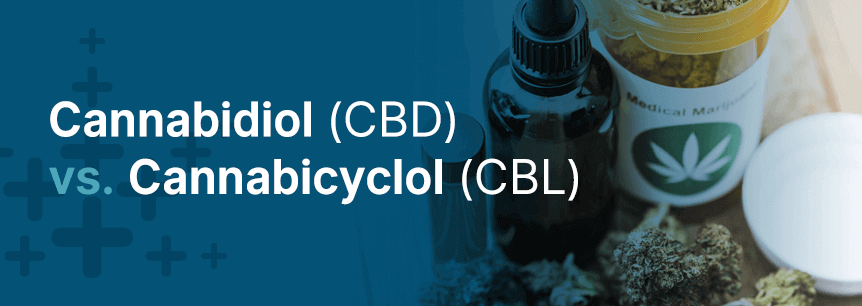
The marijuana plant contains hundreds of compounds that provide health benefits. Consider cannabis like a medicine cabinet full of remedies for a variety of ailments. Marijuana’s components can work together to relieve your symptoms in a phenomenon known as the “entourage effect.” We can also isolate compounds to create the type of medication we want. You may know about cannabidiol (CBD), one of the cannabinoid components in cannabis. In this blog post, we will compare CBD to another cannabinoid called cannabicyclol (CBL).
Cannabis has 500 natural compounds, including at least 85 cannabinoids. We categorize cannabinoids into two categories — psychoactive and non-psychoactive. Psychoactive cannabinoids like tetrahydrocannabinol (THC) create the “high” we often associate with marijuana. Meanwhile, non-psychoactive cannabinoids don’t cause that effect. While the benefits of some cannabinoids overlap with each other, each cannabinoid has unique traits.
Medical marijuana producers rely on cannabinoids to relieve patients’ symptoms. Growers can breed cannabis strains to have a high concentration of certain cannabinoids to enhance their effects. Marijuana medicine can come in a variety of formulations featuring different cannabinoid ratios. The information we have about cannabinoids informs our methods of creating medication.
Marijuana has two primary cannabinoids — tetrahydrocannabinol (THC) and CBD. We have the most research on these compounds compared to other cannabinoids because they have the highest concentrations. CBD relieves inflammation, pain, sleep problems, mood issues, and other symptoms. Many patients prefer CBD over THC because it has no psychoactive effects, and some use it in combination with THC for enhanced benefits.
CBL appears in marijuana in small concentrations, and the amount of CBL in cannabis increases as the plant ages. Light turns the cannabinoid cannabichromene (CBC) into CBL over time. The CBL molecule has no double bonds, meaning it has no psychoactive effects. Preliminary research suggests a small possibility that CBL can relieve inflammation and reduce tumors. We have plenty to discover about the medical properties of this cannabinoid.
We discovered cannabinoids half a decade ago, so we still have plenty of exciting discoveries to make about them. The stigma against marijuana in many countries also interferes with our ability to research it. In the United States, cannabis’ Schedule I status makes it difficult to study any type of cannabinoid. However, we have enough data to show marijuana’s promise, and we can’t wait to see what we learn next. Most of the research we have so far covers prominent cannabinoids like CBD instead of CBL.
Since the marijuana plant has a higher concentration of CBD than CBL, we can get more data on CBD. It is also more challenging to extract CBL than CBD. These factors contribute to the gap in knowledge between the two compounds. However, as we gain more information on cannabinoids like CBD, we will have more evidence to justify research on lesser-known compounds like CBL. The FDA and DEA’s approval of the CBD medication Epidiolex will also help us learn more about marijuana.
Cannabinoids affect our bodies by interacting with our endocannabinoid systems. The endocannabinoid system (ECS) creates and uses cannabinoids as part of our natural functions. When a cannabinoid activates one of the ECS’ receptors, the cell that has the receptor changes its behavior. CBD and CBL interact with the ECS in different ways.
CBD improves the ECS’ ability to regulate your bodily functions. Instead of attaching to a receptor, it blocks FAAH, a fatty acid that breaks down anandamide. Our bodies create the cannabinoid anandamide to improve our mood and relieve pain. When we have less FAAH, we can retain higher levels of anandamide and feel more benefits from it.
Since we don’t have much research on CBL, we don’t understand how it interacts with the ECS. For now, we can guess that it behaves like most cannabinoids and attaches to cannabinoid receptors. However, as we know from studying CBD, cannabinoids can surprise us in the ways they work with our systems. Who knows what we’ll discover in the future?
While we have plenty of CBD products to use, we don’t have any CBL medicine. Since we don’t know much about CBL, producers don’t use it to make medication. However, thanks to CBD’s boom in popularity, you can find a wide range of CBD-based products. CBD medicine comes in the form of:
Some marijuana cultivators also grow strains with high CBD content. These strains still contain THC, but often in trace amounts that make them suitable for patients who don’t want a “high.” Producers and growers have almost infinite possibilities when it comes to creating CBD products!
Due to the lack of information we have about CBL, we can’t say if one cannabinoid works better than the other. Until we learn more about CBL, we probably won’t add it to marijuana medicine. If we find out that CBL has benefits, we could use it on its own or as a supplement to CBD treatment. The availability of different types of medicine varies by state, so certain areas would have more CBL medicine than others.
When you decide on a CBD medicine, we recommend getting help from a marijuana-certified medical professional or a dispensary staff member. Even when you use CBD derived from hemp instead of marijuana, these experts can help you optimize your treatment. An authorized doctor can also help you join your state’s medical marijuana program if you want to use cannabis-derived CBD.

Learning about cannabinoids can help you get the most relief from your medicine. When you understand how each compound improves your symptoms, you can look for medications that feature them. For more information about CBD, you can check out our CBD resources blog category.
No Information on MarijuanaDoctors.Com should be used to diagnose, treat, prevent or cure any disease or condition. You can view our Full Disclaimer here.